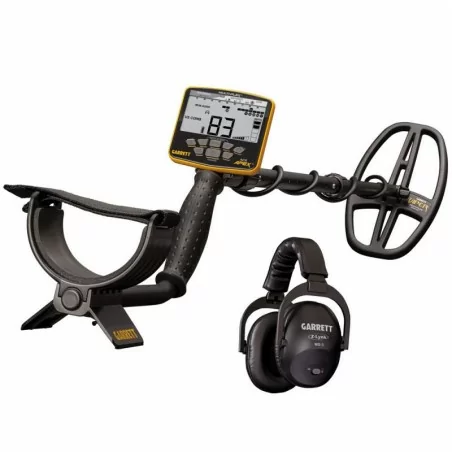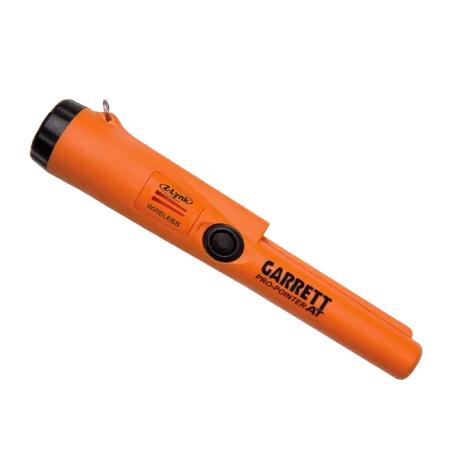5 Practical Tips to use your Garrett APEX at the Top!
The brand new Garrett ACE APEX is a state-of-the-art metal detector, equipped with:
- 4 single operating frequencies (5, 10, 15 and 20 kHz)
- 2 modes with simultaneous multi-frequency (one of which is optimized for wet beach sand)
- 1 special search coil 6"x11" DD Viper,
- 5-tone hybrid audio,
- High-resolution automatic terrain balancing,
- Iron Audio to improve search
How to best set up the GARRETT APEX metal detector for best results?
Here are the 5 tips from our expert to have top performance from your Garrett APEX!
1) Choose the correct Discrimination Mode
The Garrett APEX has 6 search modes:
- ZERO
- COINS
- US COINS
- JEWELRY
- RELICS
- CUSTOM
Each of these has a different approach to discrimination.
The expert's advice is not to exceed in discrimination to avoid losing many good targets. If we really can not manage the ZERO mode because of too much iron on your fields, a good alternative will be the RELICS, which only partially discriminates iron but which guarantees excellent performance.
If necessary, you can always add or remove a few discrimination notches to optimize the setting even more.
Continues...
Apex wireless Garrett metal detector
Garrett Pro-Pointer AT Z-Lynk
2) Choose the Right Frequency depending on the case
The great novelty of the APEX is the possibility to choose between
- 4 operating frequencies
- 2 simultaneous Multi-Frequency modes.
The intelligent selection of one of these 6 options is essential to achieve top performance..
If you are looking for military artifacts such as helmets, water bottles, bayonets or if you are looking for not so small sized targets, select the 5 kHz frequency. It will give you top results. Also choose it if you are looking for silver or copper objects, since the lowest frequencies are the most sensitive to the most conductive metals.
If you were aiming for tiny or very thin objects, you should consider the 20 kHz frequency, which is ideal for these types of targets..
Of course the other frequencies, 10 and 15 kHz, will be preferred for more general researches, such as coins or artifacts of variable size.
If you don't have a precise idea of which targets to look for, the Standard Multi-Frequency (MF) mode can be an excellent all-rounder wildcard. It may not be as super-optimized as single frequencies, but it will amaze you with flexibility and performance on all types of targets.
Finally, if you are looking for a shoreline or with the coil immersed in sea water, the Multi-Frequency Salt (MS) is a must for remarkable performance and impressive stability.
One last piece of advice... On strongly mineralized soils, in case of excessive false signals, use the 5 kHz: it is the best to penetrate these types of soils.
3) Perform a Good Ground Balance
Taking care of the initial ground balance means allowing the detector to start with the right foot in the calibration process.
Before carrying out the procedure, choose a clean soil area and check that there are no metal objects using the integrated pinpointer.
Then press and keep pressed the GND BAL button and "pump" the coil until the background sound will almost fade away. If you feel that the instrument continues to give audio responses as you lift and bring the coil closer to the ground, change places and repeat the steps above.
4) Adjust the Iron Volume
Experienced seekers tend to want to listen to ALL metals, including iron. This is because they know that very often, especially on mineralized soils, "good" and very deep objects tend to be detected as ferrous targets or in any case with much lower VDI than normal.
A correct adjustment of the volume of the iron (Iron Volume) will allow you not to lose all these targets without suffering too much acoustic stress that many ferrous targets in the ground can cause.
I suggest setting the Iron Volume to 2-3 if the soils are infested with scrap metal and to 4-5 if there is little scrap. Of course, you can also change this setting according to your needs and the conditions of your search fields.
5) When and How to use Iron Audio
Iron Audio is a very useful acoustic feature of APEX, especially in places where scrap metal can hide many good targets.
This audio mode, which can be activated with the push of a button, will allow you to hear the "grunt" of ferrous objects and at the same time the high-pitched tones of noble objects when they are very close.
It often happens that iron can "mask" desirable objects by producing broken, inconsistent or even mute signals.
By activating the Iron Audio we will allow the APEX to provide us with a double signal:
- Both with low tone (due to the presence of iron)
- Both with the remaining 4 tones (related to valid targets).
In case of a uncertain signal, therefore, do not hesitate to activate the Iron Audio and investigate the signal better, perhaps turning around.


